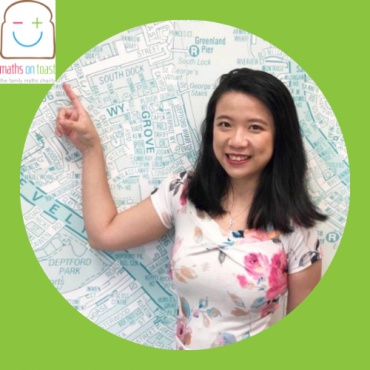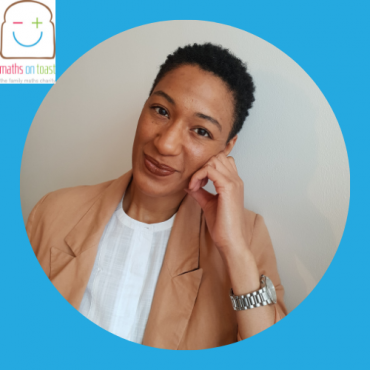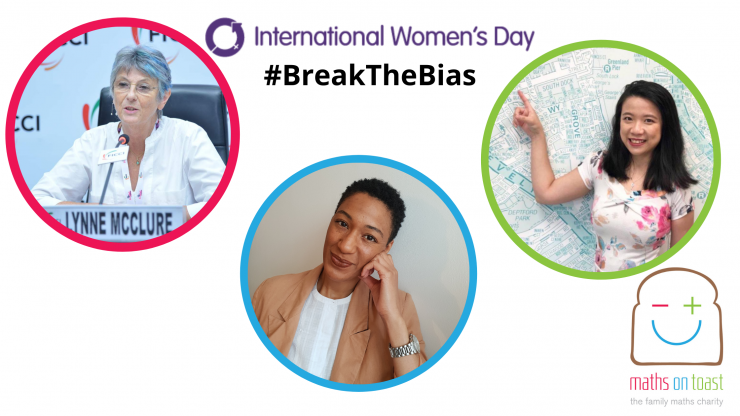For our International Women’s Day blog this year, we decided to talk to 3 women mathematicians and ask them some questions about the maths in their life.
Check out what they have to say, and then try the hands-on Maths on Toast activities we have selected inspired by our mathematical friends!
 Lynne McClure
Lynne McClure
Lynne is the Director of the Cambridge Maths team. They have developed a digital tool which will help designers of curriculum, resources, assessments and professional development to communicate maths as a coherent and connected network of mathematical ideas
Which words pop into your head when you think of maths?
Engaging, perplexing, rewarding
How do you use maths in your job?
In two ways:
- in the day to day running of a project, for example setting and monitoring the budget,
allocating time to different tasks etc. - and within the Cambridge Maths project itself, reading
mathematics education research and translating it into classroom and home practice.
How do you use maths in your daily life – interests, hobbies, sports etc?
I love painting mathematical pictures, for example copying the shape and structure of church windows, and these require a knowledge of some quite complicated geometric constructions. I am a member of a choir and that requires being able to count the beats, sometimes in very complicated pieces, to know when to sing and, more importantly sometimes, when not to! I swim every day and use different number patterns to count the number of lengths I set myself to do each week – it takes my mind off the actual swimming.
What is your favourite example of maths in the natural world, or favourite example of maths in the artistic or design world?
Mathematics for me is frequently about patterns and I enjoy identifying them in the natural world. The Fibonacci sequence is the most obvious and it always gives me a small frisson of excitement when I spot it in a flower or a seed head.
What did you think of maths / did you enjoy maths as a child?
My father was a maths teacher and would frequently offer us children interesting questions which were only just within our grasp. Sometimes we wouldn’t solve them for a few days but when we did there was a lovely sense of satisfaction. He never told us the answers!
What do you think of Maths on Toast creative maths approach?
Maths is a creative subject, it’s all around us and embedded in practically everything we do in some way or another. That’s what Maths on Toast exemplifies.
Why do you think this play-filled approach is useful?
Because getting messy in maths–physically and cognitively–is a really important part of conceptual development. There’s plenty of time for the formal stuff later.
 Karrie Liu
Karrie Liu
Karrie Liu is the founder of Hypatia Analytics Ltd and a mathematician with 10+ years of experience in UK healthcare and life sciences. She believes data and mathematics are at the heart of better decision-making and it is important to apply these insights into their planning.
Which words pop into your head when you think of maths?
I do not think about words, but I do think about the shapes, lines and patterns.
How do you use maths in your job?
Put simply, I use maths to help the NHS set up plans to look after patients.
How do you use maths in your daily life – interests, hobbies, sports etc?
I love to cook a lot, so maths used in measurement is very important.
What is your favourite example of maths in the natural world or favourite example of maths in the artistic or design world?
MC Escher is my favourite artist. His artwork Belvedere is something I love and adore. Infinity is a concept that’s used a lot in the Mathematics world. His designs can be found in money notes and also in films (such as Inception). MC Escher’s work opened my mind, he showed me maths can be in different shapes and forms. It can also be used with different disciplines. Maths can be seen as a language but also as part of something creative.
What did you think of maths / did you enjoy maths as a child?
I always enjoyed working with numbers and I found it easier to understand the world via number and patterns. I also found maths magical. I love all the maths symbols, even though I didn’t always understand their meaning at the time! My favourite one is the “%”.
What do you think of Maths on Toast creative maths approach? Why do you think this play-filled approach is useful?
Using a creative approach is amazing, I am the kind of person who learns better by playing. I found studying in the traditional classroom setting somehow gave me pressure and stress – being a student, it’s sometimes easy to lose the enjoyment about learning new things. I still remember the story of zero because I learnt it via storytelling. I believe good and happy memories can help me learn better. Often maths has a stigma – the general public think that it’s hard to learn and difficult to master. I know that playing with maths can help take out the negative feelings.
 Krystle McGilvery
Krystle McGilvery
Krystle is a trustee of Maths on Toast. After over 10 years as CIMA chartered accounted, she founded Mind Over Money and currently works as a financial consultant combining behavioural science and finance to support individuals and founders gain financial confidence.
Which words pop into your head when you think of maths?
Creativity, fun, exploration, problem solving!
How do you use maths in your job?
I create financial plans for individuals and businesses, helping them to make money, and manage the money they have.
How do you use maths in your daily life – interests, hobbies, sports etc?
When cooking, for example making meals for friends. I spend my spare time creating fine art and as part of the process, I measure the dimensions to ensure the proportions are correct.
What is your favourite example of maths in the natural world, or favourite example of maths in the artistic or design world?
The Fibonacci sequence is rather beautiful, witnessing it in shells, fingerprint and flowers every day.
What did you think of maths / did you enjoy maths as a child?
I began to love maths when I was 13 years old. I loved that as I continued to practise, I was able to better understand concepts and get the answers correct!
What do you think of Maths on Toast creative maths approach?
It is great! As someone who studied maths at college and university (twice), I can confidently say that maths is a creative art.
Why do you think this play-filled approach is useful?
It opens the door to creativity and exploration, things that are required to develop mathematical understanding.
Maths on Toast activities inspired by our three amazing women
Maths on Toast activities inspired by Krystle:
Curves of Pursuit:
https://www.mathsontoast.org.uk/activities/curves-of-pursuit/
Bake-Off challenge:
https://www.mathsontoast.org.uk/activities/maths-bake-off-challenge/
Maths on Toast activities inspired by Lynne:
Maths, art and buildings:
https://www.mathsontoast.org.uk/activities/maths-art-buildings/
Maths on Toast activities inspired by Karrie:
Data activity ‘Colour Your Day’:
https://www.mathsontoast.org.uk/activities/colour-your-day/
Escher-inspired tessellations:
https://www.mathsontoast.org.uk/activities/escher-inspired-tessellations/
Create a number character:
https://www.mathsontoast.org.uk/activities/create-a-number-character/
Lynne, Karrie and Krystle all love spotting the Fibonacci sequence in nature! Check out our Fibonacci-inspired activity here:
https://www.mathsontoast.org.uk/activities/fibonacci-inspired-art/

